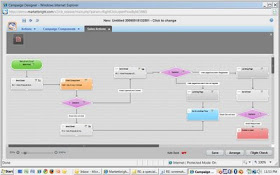(Second of three posts on demand generation interfaces.)
I spoke last week with Marketbright client Michaline Todd, director of corporate marketing at Serena Software, to see how Serena likes Marketbright’s campaign interface. Marketbright uses the two-level approach that I consider an industry best practice: users can build simple linear campaigns with a wizard-driven interface, and embed these in a Visio-style flow chart to manage flows across campaigns.

The short answer is that Serena is very pleased, since the flows make it easier to enforce complex processing rules that were otherwise difficult to define and execute. The long answer adds a few shades of gray to this rosy picture, and these are worth exploring.
- Serena didn’t build the complex campaigns for themselves. The work was done by an outside agency, Maratona Marketing. The reason was not the Marketbright interface: of the six weeks it took to develop the company's first complex flow campaign, setting it up in Marketbright took twenty minutes. Maratona spent the rest of the time on business issues such as lead scoring, process flow and content creation. This reinforces the point that most companies will need help to take advantage of the new opportunities that demand generation systems present.
- Todd felt the campaign flows were “as easy as Visio”. She meant this as praise, although I suspect that many marketers don’t find Visio all that easy. In particular, Todd said the visual diagrams helped to explain the flows to marketing and sales managers who would otherwise find them hard to grasp. Todd also noted that Serena itself sells software development tools, so its staff is already very comfortable with flow charts.
- Serena is now running into conflicts when a given prospect is in more than one marketing campaign. Marketbright handles this now by limiting each prospect to one message per day, storing any additional messages, and sending them later. The vendor plans to refine this approach by letting users prioritize the campaigns so the most important messages are sent first.
Todd cited a couple other features she appreciated. These include a “flight check” of all components before the campaign is executed and an option to view results of active campaigns by clicking on icons in the flow chart. She didn’t mention some of the limits I noted in my Raab Guide analysis of Marketbright, such as a maximum of two splits leading from any decision within the flow or the inability to create random tests without SQL coding.
We did discuss testing in general. Todd said her company doesn’t run formal a/b tests although it does review the performance of different messages to see which yield higher response. She hinted that she might add testing later but was wary of creating too much complexity in the company’s first flows. Marketbright president Erik Bower reinforced this comment, suggesting that most marketers are too busy to analyze results from many tests. Instead, Marketbright plans to add “self-optimizing” capabilities similar to Google AdWords, which will let marketers load alternative versions and have the system automatically select the better-performing option over time.
We also discussed whether an automated lead nurturing campaign can build a relationship between a prospect and the sales rep whose name is on the system-generated emails. Both Todd and Maratona’s Cari Baldwin told stories about prospects who believed the emails werebeing sent personally. This is good news for companies hoping that demand generation systems can compensate for the loss of direct contact between sales people and early-stage prospects. (See my recent white paper Restoring the Balance for more on this.) But the stories also raise a note of caution: in both cases, the prospect approached the actual sales rep at a trade show, and the rep had no idea what they were talking about. Happily, both reps handled the situation well.
(Note: MarketBright was purchased by Act-On Software two years after this post was published.)
No comments:
Post a Comment